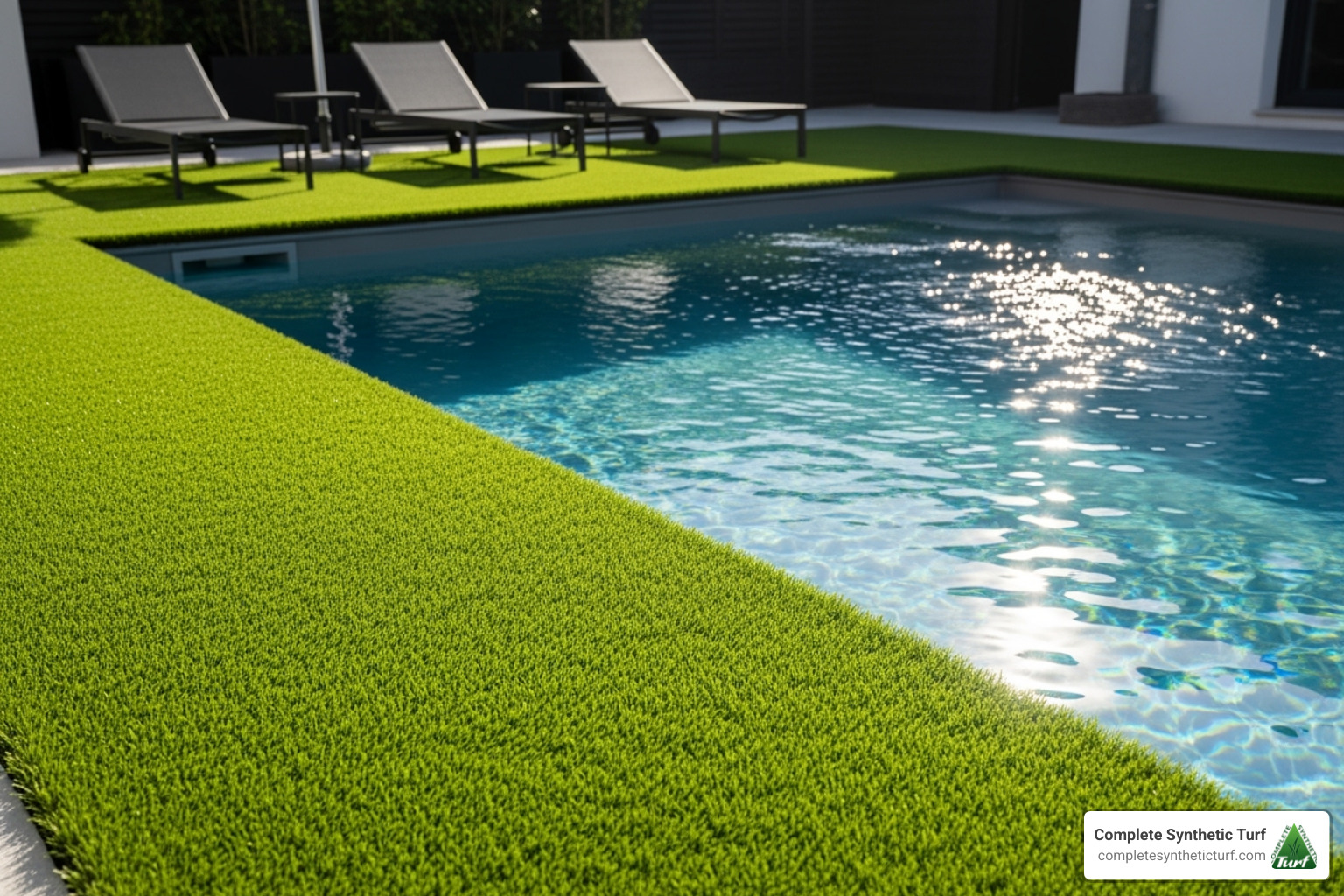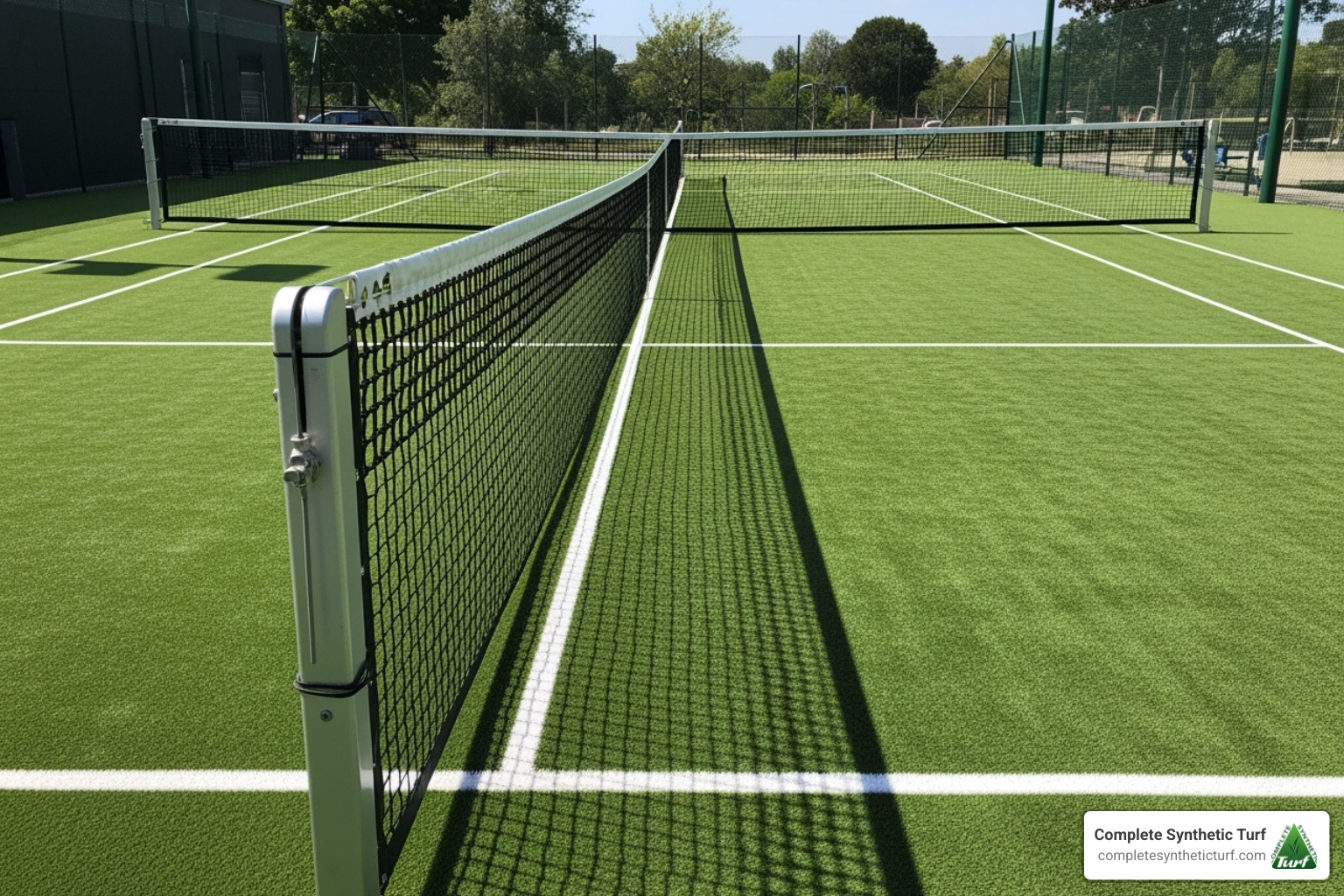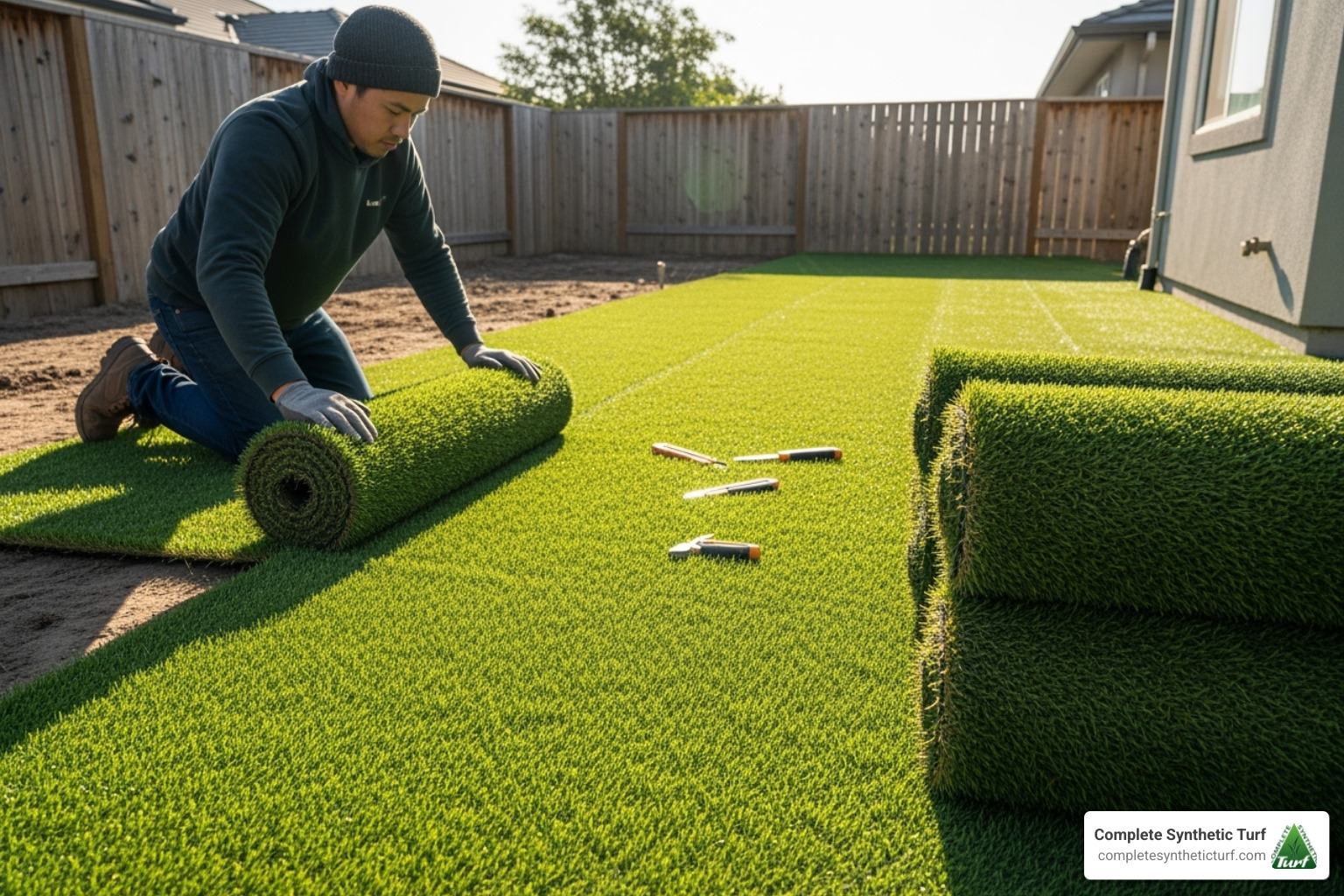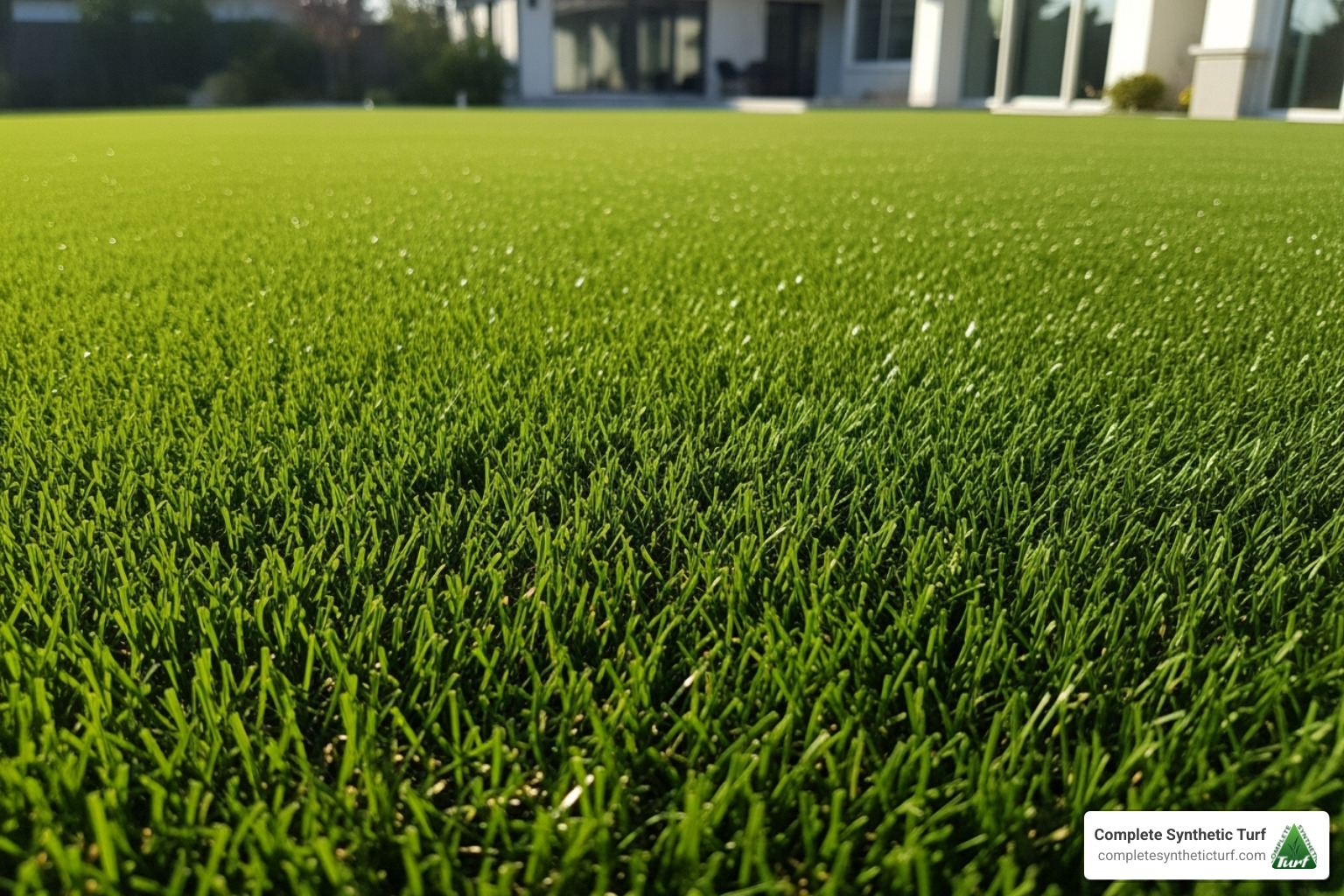Artificial Turf Around Pool: 5 Key Benefits
Why Pool Owners Are Choosing Artificial Turf Solutions
Artificial turf around pool areas has become a popular solution for homeowners seeking a beautiful, low-maintenance alternative to natural grass. For those dealing with Florida’s intense sun, high water bills, or constant pool maintenance, synthetic grass offers a practical answer.
Quick Evaluation: Is Artificial Turf Right for Your Pool?
- Best for: Homeowners wanting low maintenance, water savings, and cleaner pools.
- Safety: Offers a softer, more slip-resistant surface than concrete.
- Durability: Resists chlorine, salt water, and UV damage.
- Considerations: The initial cost is higher than grass, and it can get warm in direct sun.
- Requirements: Proper drainage and professional installation are essential.
Unlike natural grass, synthetic turf won’t suffer from chlorine contamination, won’t shed clippings into your pool, and eliminates the cycle of watering, mowing, and fertilizing. While turf can warm up in direct sunlight, it’s often cooler than concrete and can be quickly cooled with a garden hose. It’s also a safer surface for falls compared to hard decking materials. The bottom line is that artificial turf solves many common challenges of poolside landscaping while providing year-round beauty and functionality.
Artificial turf around pool terms explained:
The Pros and Cons of Artificial Turf for Pool Surrounds
Deciding on the perfect surface around your swimming pool is a big choice. Here’s a look at the pros and cons of using artificial turf around pool areas.
Key Advantages of a Synthetic Lawn
- Low Maintenance & Water Conservation: Artificial turf eliminates the need for mowing, fertilizing, and watering. This saves time, money, and a significant amount of water, which is great for the environment and your utility bills. For more on water conservation, check out the EPA’s WaterSense program.
- Cleaner Pool & Surroundings: No more grass clippings or mud being tracked into your pool or home. Synthetic turf keeps your poolside pristine and reduces the workload on your pool filter.
- Durable & Resilient: High-quality artificial turf is built to withstand heavy foot traffic and resist damage from pool chemicals like chlorine and salt. It stays green and vibrant year-round without fading from UV exposure.
- Improved Safety: Compared to hard surfaces like concrete, artificial grass provides a softer, more forgiving surface, which can reduce the risk of injury from slips and falls.
Potential Drawbacks and Considerations
While the advantages are impressive, it’s important to consider the potential downsides.
- Heat Retention: Artificial grass can get warm in direct sunlight. However, it’s often cooler than concrete and can be quickly cooled with a spray from a garden hose.

- Slipperiness When Wet: While it generally offers good grip, any wet surface can be slippery. The soft surface of turf can cushion a fall better than hardscapes.
- Initial Installation Cost: The upfront investment for artificial turf is typically higher than for natural grass, but it’s often comparable to or less than high-end pavers. This cost is offset over time by savings on water and maintenance.
- Infill Tracking: The sand infill used to keep the blades upright can sometimes be tracked into the pool on wet feet. This is a minor issue that can be managed with proper infill selection and occasional sweeping.
- Potential for Odors with Pets: If pets use the turf as a bathroom, odors can develop if not cleaned regularly. Proper drainage and specialized pet-friendly infills can largely prevent this issue.
Key Features for Poolside Turf: Safety, Durability, and Drainage
Not all artificial grass is created equal, especially for a pool area. Certain features are non-negotiable for performance and longevity.
Safety and Durability Features
When choosing artificial turf around pool areas, safety and durability are paramount. Look for products that offer a softer, more forgiving surface than concrete, which can reduce the risk of injury from falls. The turf should be non-toxic, lead-free, and bug-resistant, making it safe for the whole family. Durability is also key, as the turf needs to withstand high foot traffic, sun exposure, and pool chemicals. Look for products with advanced UV protection and a high face weight for greater resilience.
Essential Turf and Infill Characteristics
Choosing the right turf involves understanding a few key characteristics:
- Pile Height: The length of the grass blades. For poolside use, a shorter pile (1.5 inches or less) is easier to clean and maintain.
- Face Weight: The amount of material in the turf’s face. A higher face weight (70 oz. or more) means better durability.
- Blade Shape: The shape of the turf blades affects appearance, durability, and heat retention. Some shapes are designed to stay cooler in direct sun.
- Thatch Layer: A curly, brown layer at the base that adds realism and cushioning.
Infill materials are crucial for keeping the grass blades upright and providing cushioning. Here’s a comparison of common infill types:
| Infill Type | Heat Reduction | Pet Friendliness | Cost (Relative) | Notes |
|---|---|---|---|---|
| Silica Sand | Low | Good | Low | Standard, cost-effective choice. Can get hot. |
| Cooling Infill | High | Excellent | High | Reduces surface temperature by up to 30-50°F. Ideal for hot climates. |
| Odor-Control Infill | N/A | Best | Medium | Contains antimicrobial properties to neutralize odors from pet urine. |
The Critical Role of Proper Drainage
Proper drainage is crucial for a long-lasting artificial turf installation, especially around a pool. Without it, you risk water pooling, mold, and mildew.

- Permeable Backing: The turf must have a fully permeable backing to allow water to pass through.
- Base Preparation: A multi-layered base of crushed rock creates a stable, porous foundation for efficient drainage.
- Proper Grading: The ground beneath the turf must be graded with a slight slope away from the pool to prevent puddles.
In humid climates like Florida’s, excellent drainage is non-negotiable to prevent the growth of mold and mildew.
The Ultimate Guide to Artificial Grass for Pools
Crafting Compelling Content: Best Practices
Creating effective technical documentation requires clear, concise, and engaging communication. Here are some best practices to follow.
Know Your Audience
Understand who you’re writing for. Tailor your language and level of detail to their expertise, whether they are beginners, experienced users, or developers.
Clarity and Conciseness
Your documentation should be easy to understand and to the point. Use simple language, active voice, and short sentences. Define any necessary jargon.
Structure and Organization
A well-structured document is easy to steer. Organize information logically, use clear headings, and incorporate lists and visuals to improve readability.

Consistency and Actionable Advice
Maintain consistency in terminology, formatting, and tone. Focus on the user’s goals, provide concrete examples, and always include clear next steps.
The Documentation Workflow: From Idea to Publication
A structured workflow ensures quality and efficiency in creating technical documentation.
-
Planning and Research: Identify your audience, define the scope, gather information from subject matter experts, and create a detailed outline.
-
Writing and Drafting: Follow your outline, focusing on clarity and accuracy. Integrate visuals as you go.
-
Review and Editing: This is a critical stage. Perform a self-edit, then have the content reviewed by technical experts and an editor. If possible, get feedback from actual users.

-
Publishing and Distribution: Choose a platform for your documentation, such as a knowledge base or a static site. Ensure it’s easily searchable and accessible.
-
Maintenance and Updates: Documentation is a living document. Schedule regular reviews to keep it current and respond to user feedback.
Tools of the Trade
Just as we use specialized tools for our artificial turf around pool installations, creating great technical documentation requires the right software.
- Word Processors: Tools like Google Docs or Microsoft Word are great for simple documents.
- Markdown Editors: For more flexibility, Markdown editors use simple text formatting that can be converted into websites or PDFs.
- Static Site Generators: For larger projects, tools like Jekyll or Hugo can build professional documentation websites from your text files.
- Content Management Systems (CMS): Platforms like WordPress or Confluence are excellent for managing large volumes of content.
- Screenshot and Diagramming Tools: Use tools like Snagit for screenshots and Lucidchart for diagrams to make your content clearer.
- Version Control Systems: For collaborative projects, systems like Git are essential for tracking changes.
The right tool depends on your project’s scale and your team’s needs. Start simple and add more advanced tools as you grow.
Common Pitfalls to Avoid
Creating effective technical documentation means avoiding common traps that can make it confusing or unhelpful.
- Writing for Yourself: Always write from the user’s perspective, not your own.
- Outdated Information: Inaccurate documentation erodes user trust. Keep your content current.
- Jargon Overload: Avoid using technical terms without explaining them.
- Poor Organization: A confusing structure makes it hard for users to find information. Use clear headings and a logical flow.
- Ignoring Feedback: User feedback is invaluable for identifying areas for improvement.
- No Clear Next Steps: Always guide the user on what to do next.
- Assuming Knowledge: Don’t assume your readers know certain basics. It’s better to over-explain than to leave a user confused.
Conclusion: Documentation as an Asset
Think of technical documentation as an investment. Just as our artificial turf around pool areas transforms outdoor spaces, well-crafted documentation transforms complex information into a usable resource.
Good documentation is a strategic asset. It empowers users, reduces the load on support teams, and helps new team members get up to speed quickly. Clarity builds confidence and fosters lasting customer relationships.

Whether you’re documenting a complex software system or explaining how to maintain a pristine outdoor space, the principles are the same. Start with your users’ needs, write clearly, and never stop improving. At Complete Synthetic Turf, we believe that attention to detail and clear communication make all the difference, whether we’re installing turf or sharing knowledge. Excellence is always worth the investment.
Tools of the Trade
Just as we use specialized tools for our artificial turf around pool installations at Complete Synthetic Turf, creating outstanding technical documentation requires the right set of tools. The good news? You don’t need to break the bank or master complex software to get started.
For many teams, word processors like Microsoft Word or Google Docs provide everything needed for simple, standalone documents. These familiar tools offer collaborative editing, commenting, and basic formatting – perfect for internal process guides or simple user manuals. Google Docs particularly shines when multiple team members need to contribute and review content simultaneously.
If you’re looking for something more flexible and future-proof, Markdown editors deserve serious consideration. Markdown uses simple text formatting that can be easily converted to websites, PDFs, or other formats later. Think of it as writing in plain text with a few simple codes for headers and bold text – much like how our synthetic turf provides a clean, uniform base that can be adapted for different applications.
For teams managing larger documentation projects, static site generators like Jekyll, Hugo, or Sphinx transform plain text files into professional websites. These tools are particularly popular with developer teams because they integrate seamlessly with version control systems and can automatically publish updates when content changes.
Content management systems offer a more user-friendly approach for non-technical teams. WordPress with appropriate plugins, Confluence, or specialized knowledge base platforms like Zendesk Guide provide robust features for organizing large volumes of documentation. These systems often include built-in search functionality, user feedback mechanisms, and analytics – invaluable for understanding how your documentation performs.
Visual content makes or breaks technical documentation, which is why screenshot and annotation tools are essential. Tools like Snagit or Lightshot let you capture clear images and add arrows, callouts, and highlights that guide users’ attention exactly where it needs to go.
For explaining complex processes or system relationships, diagramming tools like Lucidchart or draw.io help transform confusing concepts into clear visual workflows. Just as we create detailed installation plans before laying turf, these tools help you map out information flows before writing.
Finally, don’t overlook version control systems like Git, especially for collaborative projects. While they might seem intimidating at first, they ensure that multiple writers can work on the same project without accidentally overwriting each other’s work – and you can always roll back to previous versions if needed.
The key is starting simple and growing your toolkit as your documentation needs evolve. Most successful documentation projects begin with basic tools and gradually adopt more sophisticated solutions as the team and content library expand.
Common Pitfalls to Avoid
Creating effective technical documentation is like installing artificial turf around pool areas – there are specific challenges that can trip you up if you’re not careful. We’ve seen countless documentation projects start with great intentions, only to fall into predictable traps that make them less useful than they could be.
The biggest mistake we see is writing for yourself instead of your audience. It’s natural to assume others share your knowledge level, but what seems crystal clear to you might be completely confusing to someone encountering your product for the first time. This is especially common when developers write user guides – they understand the technical underpinnings so well that they forget to explain the basics.
Outdated documentation is actually worse than having no documentation at all. When users follow instructions that no longer work, they lose trust in your entire knowledge base. We’ve learned this lesson in our own industry – if we told customers that a certain turf works great around pools but failed to mention it’s been discontinued, we’d create more problems than we’d solve.
Jargon overload is another documentation killer. Every industry has its specialized language, and while these terms might be second nature to you, they can be intimidating barriers for newcomers. The key is finding the right balance – use technical terms when necessary, but always define them clearly.
Poor organization turns even the best content into a frustrating maze. When users can’t find what they’re looking for quickly, they’ll either give up or flood your support team with questions. Think of your documentation structure like a well-designed landscape – everything should have a logical place and clear pathways between sections.
Ignoring user feedback is like turning your back on your most valuable resource. When multiple users struggle with the same section, that’s your documentation telling you it needs improvement. Pay attention to support tickets, comments, and questions – they’re goldmines of insight into where your documentation falls short.
Many documents also suffer from unclear next steps. After explaining a concept or procedure, always tell readers what to do next. Should they move to the next section? Try a specific action? Contact support? Don’t leave them hanging.
Finally, assuming background knowledge can exclude entire groups of potential users. What seems like basic information to you might be the missing piece someone needs to succeed. When in doubt, explain more rather than less – experienced users can always skim past information they already know.
Conclusion: Documentation as an Asset
Think of technical documentation the same way we think about artificial turf around pool areas – it’s an investment that pays dividends for years to come. Just as our synthetic turf transforms challenging outdoor spaces into beautiful, functional areas that require minimal upkeep, well-crafted documentation transforms complex technical information into something your users can actually understand and use.
The truth is, documentation isn’t just another box to check off your project list. It’s a strategic asset that works around the clock for your business. When users can find answers on their own, they feel empowered and confident. When your support team isn’t drowning in the same repetitive questions, they can focus on solving more complex problems. When new team members can get up to speed quickly, your entire operation runs more smoothly.
We’ve seen this principle at work in our own field. A customer who receives clear installation guidelines and maintenance instructions becomes a satisfied customer who enjoys their investment for years. The same applies to any technical product or service – clarity breeds confidence, and confidence builds lasting relationships.
The key ingredients we’ve explored throughout this guide – knowing your audience, writing with clarity, organizing information logically, and keeping everything current – aren’t just nice-to-haves. They’re the foundation of documentation that actually serves its purpose. When you accept these principles, you’re not just writing instructions; you’re creating a bridge between what you know and what your users need to succeed.
Every question that gets answered through good documentation is a win for everyone involved. Your users get instant help, your team gets breathing room, and your product gets the chance to shine without confusion getting in the way.

Whether you’re documenting a complex software system or explaining how to maintain a pristine outdoor space, the fundamentals remain the same. Start with your users’ needs, write clearly, organize thoughtfully, and never stop improving. Your future self – and your users – will thank you for the effort.
Ready to tackle your next documentation project? At Complete Synthetic Turf, we believe that attention to detail and clear communication make all the difference, whether we’re installing turf or sharing knowledge. Excellence is always worth the investment.




